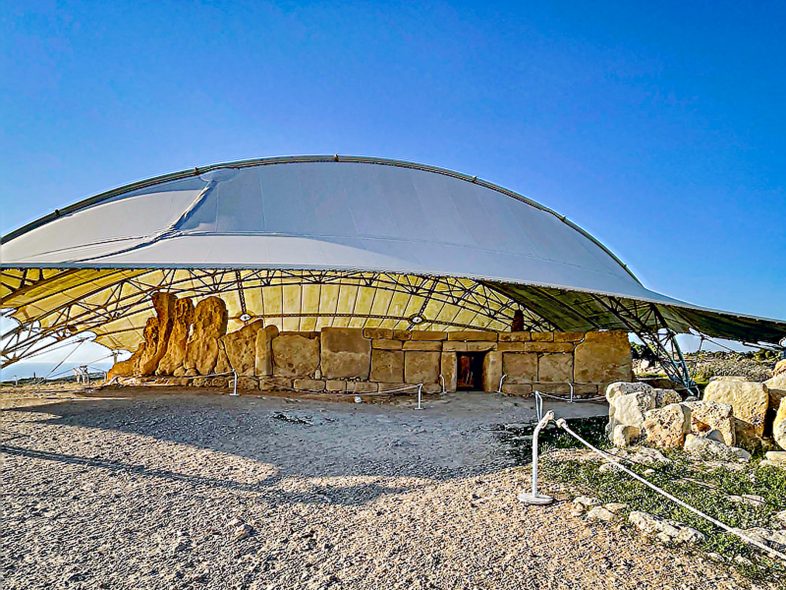Most original people of the Middle East, Europe, North Africa and Western Asia have two fathers and they and their children spoke a unified language developed deep in the Stone Age. The two letters ‘p’ and ‘g’ are significant because in original form they were used by one branch of speakers and therefore easily identifiable. Malta has a single four-letter word that appears to suggest who were the original inhabitants of the islands, where did they come from and, roughly, in which millennium ‒ Gozo a sister of Gaza, an ancient coastal city in Palestine. The ‘ġ’ (ghayn) in Ġaza is a variant of the original ‘g’.
In Stone Age etymology, Gozo is a standard compound of two biliteral roots: go and zo. The first is the name of the only universal God of Homo Sapiens: ۞AGÛ which is ENG ago, go and age. The second is also the great God ۞ZȖ. Malta should have a Stone Age name. It should be in two letters or four letters. A three-letter name would be a post-Agricultureal Era triliteral.
Malta is a triliteral of the BR (biliteral root of two letters) *ML and the the letter ‘t’. This is a typical triliteral developed during the Agricultural Era for specification. From *ML Arapīte and ARB mala’ ملأ: fill up with; charge with; load with. From the same BR ARB milaḥa ملاحة: sail on or across a sea or a river – navigation.
The meaning “fill” is in ENG melon (*ML + n) because it has a great deal of juice, a mile is a long distance, and million is a big number.
From the Akkadian language extensions from the same BR:
- malallû : [Transport → Sea] a type of freight boat : a freight boat ;
- mālaltu : [City → Buildings] 1) a post (?) ; 2) a beam (?) ;
- maldudu: in a boat : a curtain (?) ;
- mallāḫu : [Professions] 1) boatman , sailor , seaman , mariner , ship master , a sea captain , a skipper + , pilot + ; 2) boatwright , shipwright
- mallāḫūtu : [Transport → Sea] navigation , sailor’s trade , seamanship ;
- malû : G. to be full, become full ; to fill (with : +acc.) D. to fill (with : +acc.); to inlay.
If Phoenicians called the Islands Maleth then it derives from the same BR, ML. The ARB version is Malaḏ ملاذ: asylum; harbor; haven; hideaway; recourse; refuge; resort; retreat; sanctuary; shelter; expedient; safety.
The impression is that Malta got its name because it has ports and storage area, perhaps by Phoenician or Canaanite or Carthaginian traders using the island as a distributing point to trade with North Africa and South Europe. They remained in Malta until the Romans took the islands in 218 BC.
The main port may have been Marsaxlokk which appears to be Marsa al Sharq, i.e., the Eastern Port.

I miss professor Wettinger, Malta’s Outstanding Authority on its Medieval History. I visited his flat several times, one with my eldest son, Sammy, met at the University and we talked at length about the origin of the Maltese language but I have a somewhat different view.
Frankly, I’m pissed off every time I hear that Maltese is a dialect of Arabic, which is a bit odd because I am a native speaker of Arabic. A good etymologist does not need more than a few words to suggest a limited origin of most living languages. The fact that Maltese uses the definite article al/el/il is a certain proof of its Arabic influence but we have to understand that al/el/il is not just a definite article but the Stone Age origin of Allah, Elohim and EL. If that’s not enough permit to add it is also the origin of English altitude, illuminate, etc. Yes, English and many other languages share many of the Stone Age roots alongside Akkadian, Arabic and Maltese.
However, the al/el/il influence is recent in etymology terms because it is an ancient knowledge stretching perhaps 70,000 years. The fact that Maltese serves the letters “g” and “p” is a certain indication that another layer of the language is much older because neither letter is served by modern Arabic. The additional fact that “g” is migrated to “j” and both are used may indicate a period of several thousand years between the time when “g” was used and the time its substituted version “j” was introduced.
Maltese etymologists are advised to study the toponyms of the islands and their ancient sites because toponyms change little over time and they almost always mean something. It is nice to say that Gozo’s history goes back to 5000 BC when a group from Sicily succeeded in crossing over on some form of sea-craft. But what physical proof do we have? Maybe they didn’t cross over and they didn’t have to because they were already residents. Dating ancient sites does not mean dating the origins of the people who built them.
The fact that the name Gozo remains in original “g” should send back its history four or five thousand years more. Additionally, Gozo is not just a place name; it is a testimonial of something cataclysmic that forced the application of the name on the island. The same applies to Ġgantija. Did anybody notice that both Gozo and (Ġ)gantija have the same Stone Age root *G’? And what about “God”? Should it join Gozo and (Ġ)gantija? It could only derive from *G’ or *GD. If “good” is related to God then its root is *GD. If it isn’t then *G’.
What about (ĦAĠAR) Qim? Well, “qi” is also a “q” migration from “g”. Surely, etymologists have heard of the Ancient Egyptian God Qaha? This could be more significant than we may think. ĦAĠAR Qim (“Standing/Worshipping Stones”) is just “standing,” not worshipping as well. If that’s the case how can we explain why Arabic Quranic Qayyum is an epithet of Allah? Who, exactly, was the God that people prayed to before the advent of the so-called monotheism, not that He was not supremely “mono”?
The questions are many but they appear to have a single answer. Unfortunately, this writer is not ready to discuss the Stone Age origins of Maltese because its entire history is a small part of the greatest event that changed the course of the history of Homo Sapiens. Everything takes time and one has to be very careful and guarded by scepticism.
If I am pressed to make a suggestion that permits me to change my mind later it would be this one: Maltese has most of the Stone Age roots found in Ancient Arabian, a Stone Age tongue that gave birth to daughters such as Ancient Arabic, Akkadian (Babylonian & Assyrian), Gerhamite, etc. Even if modern Arabic is considered an additional layer, Arabic itself is based on those same Stone Age roots. This means both languages are joined at Stone Age level and both should be considered sisters.
How could Maltese by a dialect of Arabic when two significant letters are served by one and not the other? The letter “g” is migrated to k, j, q and sometimes y. The letter “p” is migrated to b, f and v (vie = Fr. “life”). If one were to add the extensions of the original “g” and “p” and all their substitutions probably up to a third of all entries in the dictionaries of major languages are generated from two original letters both of which were invented by the nation of ‘Aad (the future Assyrians), one of two nations that may constitute today perhaps two thirds of humanity. The second is the nation of ’Ad whose name was extended in post Agricultural Era to Adam.
A great deal depends on the findings of a systematic study of dialectal Gozitan and whether Gaulos originally was called *G’ + *L’ for something such as Gala or Gola. If this can be proven it could be a Stone Age toponym probably 10,000 years old, at least.
Another point to be considered is this: If a certain place was named Gozo, for example, and its population were transported somewhere else and new population became residents we may not expect the name Gozo to be used by entirely different population. A human continuity based solely on the continuity of attested toponyms may not be dismissed without a good fight.
*Adel Bishtawi is author of Origin of “Semitic” Languages found at Amazon and other online outlets. His newest book is The Common Stone Age Origins of English, Akkadian and Arapīte & Greatest Gods of Homo Sapiens released in May 2023.
Last modified: May 26, 2023



